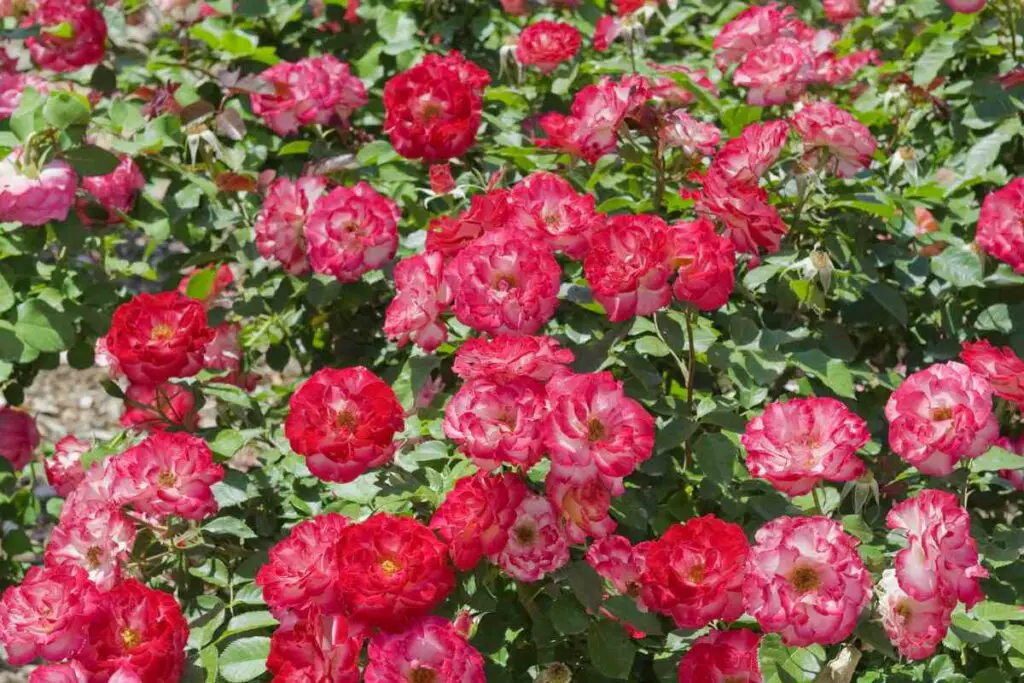In this article, you will learn how to cultivate and care for these beautiful flowers, which are known for their ability to bloom repeatedly throughout the growing season.
We will cover everything from choosing the right variety of roses for your garden to proper planting techniques to ongoing care and maintenance.
Whether you are an experienced gardener looking to add everblooming roses to your collection, or a beginner just starting out, this guide has something for everyone.

So grab your gardening gloves and let’s get started on creating a stunning everblooming rose garden!
Table of Contents
Different Varieties of Everblooming Roses
There are several varieties of Knock Out roses and other everblooming roses that are popular with gardeners. Some examples include:
- The original Knock Out rose, is a hardy, disease-resistant variety that produces cherry red flowers.
- The Pink Knock Out rose, has pale pink flowers and a compact, mounding habit.
- The Double Knock Out rose, has double the petals of the original variety and produces deep pink flowers.
- The Rainbow Knock Out rose, which has multi-colored flowers in shades of red, yellow, and pink.
- The Sunflower Knock Out rose, has vibrant yellow flowers and a lemony scent.
Other popular everblooming roses include the Carefree Wonder rose, which has large, pink flowers and a vigorous growth habit, and the Flower Carpet rose, which has a low, spreading habit and produces a continuous display of red, pink, or white flowers.
There are many other varieties to choose from, so be sure to do your research and select the one that best suits your garden and your personal preferences.
But First, Check out these beautiful Double Knock out Plants below.
Prices pulled from the Amazon Product Advertising API on:
Product prices and availability are accurate as of the date/time indicated and are subject to change. Any price and availability information displayed on [relevant Amazon Site(s), as applicable] at the time of purchase will apply to the purchase of this product.
Step-by-Step Guide on How To Grow Everblooming Roses
Here is a step-by-step guide on how to grow everblooming roses:
- Choose the right location: Everblooming roses thrive in sunny, well-draining locations. Select a spot in your garden that gets at least six hours of direct sunlight per day.
- Prepare the soil: Roses prefer rich, loamy soil that is high in organic matter. Before planting, mix in compost or well-rotted manure to improve the soil structure and fertility.
- Select the right rose variety: As mentioned earlier, there are many different varieties of everblooming roses to choose from. Consider the size and growth habits of the plant, as well as the color and type of flowers you want.
- Plant your roses: When planting everblooming roses, be sure to dig a hole that is wide and deep enough to accommodate the root system. Place the rose in the hole so that the bud union (the swollen area near the base of the plant) is about 2 inches below the surface of the soil. Backfill the hole with soil, tamping it down gently to eliminate any air pockets.
- Water your roses: Water your newly planted roses thoroughly, and then water them deeply once a week (unless there is sufficient rainfall). Avoid getting water on the foliage, as this can encourage the development of fungal diseases.
- Fertilize your roses: Use a balanced fertilizer (such as 10-10-10) to feed your roses throughout the growing season. Follow the instructions on the label for the appropriate amount to use.
- Prune your roses: Prune your everblooming roses in late winter or early spring, just before new growth begins. Cut out any dead, diseased, or damaged branches, and remove any suckers (new shoots that emerge from the base of the plant).
- Monitor for pests and diseases: Keep an eye out for common rose pests such as aphids, Japanese beetles, and rose slugs, and treat them as necessary. If you notice any signs of fungal diseases such as black spots or powdery mildew, use a suitable fungicide to treat the problem.
By following these steps, you can successfully grow and care for a beautiful everblooming rose garden. With a little patience and attention, you will be rewarded with a continuous display of stunning flowers.
Tips For Maintaining Growth In Everblooming Roses
Here are some tips for maintaining the growth of your everblooming roses:
- Water regularly: Roses need a consistent supply of water to maintain healthy growth. Water your roses deeply once a week, or more frequently if the weather is hot and dry. Avoid getting water on the foliage, as this can encourage the development of fungal diseases.
- Fertilize regularly: Use a balanced fertilizer (such as 10-10-10) to feed your roses throughout the growing season. Follow the instructions on the label for the appropriate amount to use.
- Prune regularly: Prune your everblooming roses in late winter or early spring, just before new growth begins. This will encourage the development of healthy new growth and help your roses maintain their shape.
- Protect from pests and diseases: Keep an eye out for common rose pests such as aphids, Japanese beetles, and rose slugs, and treat as necessary. If you notice any signs of fungal diseases such as black spot or powdery mildew, use a suitable fungicide to treat the problem.
- Provide proper support: If you are growing climbing roses or other varieties with a tall, sprawling growth habit, be sure to provide a sturdy trellis or other support for the plants. This will help prevent the stems from breaking under the weight of the flowers.
By following these tips, you can help your everblooming roses thrive and maintain their healthy growth.

What Soil Should You Use To Grow Everblooming Roses?
Roses prefer rich, loamy soil that is high in organic matter. This type of soil is well-draining and has a good balance of nutrients, which is ideal for growing roses.
If your soil is heavy or clay-like, you may want to mix in some compost or well-rotted manure to improve the structure and drainage.
It is also important to make sure your soil is pH-balanced for roses. Most roses prefer a soil pH that is slightly acidic, between 6.0 and 6.5. You can test the pH of your soil using a soil test kit, which is available at most garden centers.
- POTTING SOIL FOR FLOWERS: Organic potting soil blend specifically designed for your flowers
- 20 QUARTS: 20 quarts of soil is ideal for your planting bed or container garden
- HEALTHIER PLANTS: Specially formulated for roses to encourage stronger roots, healthier stems and leaves, and more vibrant petals
- ORGANIC BLEND: Blended from natural ingredients such as compost, bark, lime, and peat moss for a safe, nutrient-rich growing medium
- REINVENT OLD PLANTER BEDS: Revitalize your existing bed with just a top la
Prices pulled from the Amazon Product Advertising API on:
Product prices and availability are accurate as of the date/time indicated and are subject to change. Any price and availability information displayed on [relevant Amazon Site(s), as applicable] at the time of purchase will apply to the purchase of this product.
If your soil is too alkaline, you can lower the pH by adding sulfur to the soil. If it is too acidic, you can raise the pH by adding lime.
In addition to the above, it is also important to make sure your soil has adequate drainage. Roses do not like to sit in water-logged soil, as this can lead to root rot. To improve drainage, you can add sand or perlite to the soil, or plant your roses in raised beds.
By providing your everblooming roses with the right type of soil, you can help ensure that they have the optimal growing conditions to thrive.
Can Knock Out Roses Grow Through Winter?
Everblooming roses, like other roses, are hardy plants that can survive through winter in many parts of the world.
However, they may lose their leaves and become dormant during the colder months. In regions with very cold winters, it is a good idea to provide some extra protection for your everblooming roses to help them survive the winter.
One way to do this is to mulch around the base of the plants with a layer of straw, leaves, or evergreen boughs. This will help insulate the roots and protect them from extreme temperature fluctuations.
It is also a good idea to prune your roses back in late fall or early winter to remove any dead or damaged branches and to help the plant conserve energy.
In regions with extreme cold, you may need to provide more extensive protection for your everblooming roses. This may include covering the plants with a layer of burlap or a rose cone, or even digging up the plants and potting them for the winter.
By following these steps, you can help your everblooming roses survive through the winter and be ready to bloom again in the spring.
Should You Grow Everblooming Roses Indoors or Outdoors?
Everblooming roses can be grown both indoors and outdoors, depending on your personal preferences and the climate in your region.
If you live in a region with a warm, temperate climate, you can grow everblooming roses outdoors in your garden. If you live in a colder climate, you can still grow everblooming roses outdoors, but you may need to provide some extra protection for the plants during the winter months.
If you prefer to grow everblooming roses indoors, you can do so by planting them in pots or containers and keeping them in a sunny window or under grow lights.
Keep in mind that indoor roses will need a consistent supply of water and light, and they may not bloom as prolifically as outdoor roses.
In general, everblooming roses are best suited for outdoor cultivation, as they require plenty of sunlight and well-draining soil to thrive.
However, with proper care, it is possible to grow these beautiful flowers indoors as well.
How Long Do Everblooming Roses Live?
The lifespan of an everblooming rose can vary depending on the variety, the growing conditions, and the care it receives.
In general, well-cared-for everblooming roses can live for many years, with some varieties living for up to 20 years or more.
To maximize the lifespan of your everblooming roses, it is important to provide them with proper care and maintenance.
This includes watering them regularly, fertilizing them regularly, pruning them regularly, and protecting them from pests and diseases. It is also important to plant them in a location that meets their growing requirements, such as a sunny, well-draining spot in the garden.
By following these guidelines, you can help your everblooming roses live a long and healthy life, providing you with years of enjoyment.
Conclusion
In conclusion, growing everblooming roses can be a rewarding and fulfilling hobby for gardeners of all skill levels.
These beautiful flowers are known for their ability to bloom repeatedly throughout the growing season, adding color and beauty to the garden. With the right care and attention, everblooming roses can thrive and provide years of enjoyment.
By following the steps outlined in this guide, you can successfully grow and care for a stunning everblooming rose garden.
So why wait? Start planning your everblooming rose garden today and enjoy the endless blooms and beauty these flowers have to offer!
- How to Build a Planter Box for Bamboo: A Step-by-Step Guide

- Can Robotic Lawnmowers Handle Steep Slopes?

- Do You Need a Specific Lawn for a Robotic Lawnmower? Expert Advice

- Are Robotic Lawnmowers Safe for Pets and Children? Safety Features of Robotic Lawnmowers

- Why Use Robotic Lawnmowers? Advantages of Using a Robotic Lawnmower

- Is the GARDENA SILENO City 300 Cordless or Corded? A Clear Answer
















